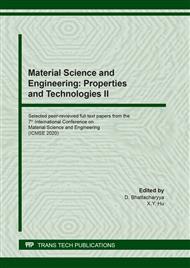[1]
Fan Hongjun. Fire and Explosion Danger of Industry Nitrification Process and Accident Prevention Inquiry. Guangzhou Chemical Industry, 2013.41(2):174-176.
Google Scholar
[2]
Gao Chongmi, Zhang Huan. Frequent major accidents-Three questions about Nit reification Enterprise safety. China Petroleum and Chemical Industry, 2018 (8): 41-43.
Google Scholar
[3]
Hu Rongzu, Zhao Fengqi, Gao Hongxu, et al. Thermal Safety of 2, 2, 2-Trinitroethyl-N-nitromethyl Amine. Acta Phys.-Chim.sin.2013, 29 (10): 2071~(2078).
Google Scholar
[4]
Zhen Chaomin, Wang Qiong, Ding li, et al. Evaluating the Thermal Safety of Propellants by Critical Temperature of Thermal Explosion. Chinese Journal of Energetic Materials, 2015, Vol.23 No.6, 548-552.
Google Scholar
[5]
Liu Ziru, Yue Pu, Ren Xiaoning, et al. Investigation on Activation Energy of Heat Explosion. 2011, 34(6): 58-63.
Google Scholar
[6]
Yu Yi, Zhang Lei, Jiang Shengli, et al. Decomposition of TATB at High Temperature Using Ab Initio Molecular Dynamic. CHINESE JOURNAL OF HIGH PRESSURE PHYSICS, 2018, 32(1): 010106-1~010106-8.
Google Scholar
[7]
Zhu Yong, Wang Yu, Liu Jianli, et al. Thermal Effects of Synthesis Process of ADN. Chinese Journal of Energetic Materials, 2012, 20(6): 735-738.
Google Scholar
[8]
Zhou Cheng, Li Xiangzhi, Wang Bozhou, et al. Study on high safety synthesis of FOX-7. Chemical Propellants & Polymeric Materials,2015.13 (5): 56-58.
Google Scholar
[9]
Chen Wanghua, Chen Liping, Li Chunguang, et al. Classification Investigation on Thermal Hazards in Nitration and Sulfonation Reactions of Benzene and Toluene. China Safety Science Journal, 2010.20(5): 67-74.
Google Scholar
[10]
Chen Liping, Chen Wanghua, Peng Jinhua, et al. Thermal Hazard Analysis of Dinitrotoluene Nitration. Chinese Journal of Energetic Materials, 2010, 18(6): 706-710.
Google Scholar
[11]
Liu Ronghai, Chen Wanghua, Hu Yiting. Safety principle and evaluation technology of hazardous chemicals. Chemical Industry Press, August (2004).
Google Scholar
[12]
Chen Wanghua, Peng Jinhua, Chen Liping. Translation. Thermal Safety of Chemical Processes:Risk Assessment and Process Design. Chemical Industry Press, (2004).
Google Scholar
[13]
Jin Shaohua, Song Quancai. Exolosive Theory. Northwestern Polytechincal University Press, (2010).
Google Scholar
[14]
Zhou Peng, Zhu Yina, Chen Liping, et al. Analysis on the Thermal Stability of Materials During the Synthesis of DINA by Magnesium Nitrate Method. Contemporary Chemical Industry, 2019.48(10): 2292-2296.
Google Scholar


